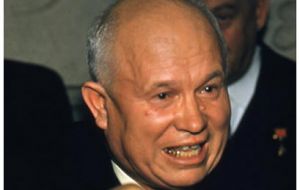MercoPress. South Atlantic News Agency
The Crimean oblast at the heart of a dispute that goes deep into Russian history
 The oblast was transferred to Ukraine in 1954 when Nikita Khrushchev was consolidating his leadership
The oblast was transferred to Ukraine in 1954 when Nikita Khrushchev was consolidating his leadership On February 27, 1954 Pravda published a short announcement on its front page that the Presidium of the Supreme Soviet of the USSR had decreed on February 19 the transfer of the Crimean oblast' from the RSFSR to the Ukrainian Soviet Socialist Republic.
The decree, which ran a mere eight lines, stated that this measure was being taken because of “the economic commonalities, territorial closeness, and communication and cultural links” between Crimea and Ukraine. Page two contained a summary of the discussion in the Supreme Soviet's Presidium and transcripts of speeches by six of its members including the chairman, Klement Voroshilov.
Several of the speakers, including Voroshilov, referred to the three-hundredth anniversary of the “unification of Ukraine with Russia,” a reference to the Treaty of Pereiaslavl of 1654 concluded between Ukrainian Cossacks and representatives of the Muscovite Tsar. All characterized the transfer as symbolizing the strength of brotherly ties between the peoples of the Soviet Union.
But why was this done? Was it, as was described at the time and for decades thereafter, a “gift” to Ukraine? If so, what motivated such generosity? After all, Crimea, the rugged peninsula jutting into the Black Sea, had not become territorially contiguous with Ukraine all of a sudden. Moreover, its cultural links with Ukraine were not nearly as strong as with Russia. According to the 1959 census, there were 268,000 Ukrainians but 858,000 ethnic Russians living in Crimea. As for economic “commonalities,” the main industry of Crimea was recreation and tourism which drew its clientele from throughout the USSR.
Before the Great Patriotic War (WW II), Crimea was home to over 300,000 Tatars, descendants of the Great Horde that moved across Anatolia and settled in the peninsula beginning in the thirteenth century. Because of the collaboration of some Crimean Tatars with Nazi occupiers during 1941-43, the entire community was deported in May 1944.
The following year, the Crimean Autonomous Republic was abolished and replaced by the Crimean oblast. It was this entity that was transferred to the Ukrainian SSR in 1954 and remains, at least for the time being, a part of post-Soviet Ukraine. A gift that was at the time essentially meaningless has acquired great historical importance, unless it was part of dealings inside the Kremlin to consolidate chairman Nikita Khrushchev's power following the death of Joseph Stalin in 1953.
An oblast is a type of administrative division in certain Slavic countries, including some countries of the former Soviet Union. The word “oblast” is a loanword in English, but it is nevertheless often translated as “area”, “zone”, “province”, or “region”. The last translation may lead to confusion, because the subdivision of “oblast” is called “raion” which is translated as “region” or “district”, depending on the context.




Top Comments
Disclaimer & comment rules-

-

-

Read all commentsMilitarily seized and ethnically cleansed and then a referendum.
Mar 15th, 2014 - 05:15 am 0Argentineans should be on the side of the Tartars if that is the case and denouncing Russia. After all, this is supposedly the worse thing an empire can do and this time it isn't a myth like the Malvinas but actually happened
1
Mar 15th, 2014 - 12:47 pm 0Ethnically cleansed ??
Actually I understand what you mean but the actual first to settle on the Penninsula were the Scythians Milenniums before the Golden Horde of Subotai one of Ghengis Khan's Generals.. So the Tatars are not really native so to speak
Interesting to learn about 'oblasts' and 'raions' although the crappy spellchecker doesn't like them, I do!
Mar 15th, 2014 - 02:44 pm 0Commenting for this story is now closed.
If you have a Facebook account, become a fan and comment on our Facebook Page!